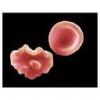Reputation Activity
-
 NewBBSup reacted to Dansket in Computer CrossmatchingThe user (not the computer) in my facility selects a RBC component from the refrigerator for crossmatching.
NewBBSup reacted to Dansket in Computer CrossmatchingThe user (not the computer) in my facility selects a RBC component from the refrigerator for crossmatching.
Are you restricting the definition of a crossmatch to include only serological methods? In 1987 the AABB allowed users to limit the serological crossmatch to the immediate-spin test if the antiglobulin antibody screen test was negative. Then, in 199?, the AABB allowed users to replace the immediate-spin crossmatch with a "computer crossmatch" to detect ABO incompatibility. Before this, the word "crossmatch" was prefaced with "major" and "minor". So the definition of "crossmatch" has undergone many changes over the years.
The FDA allows Transfusion Services to use a qualified computer system to detect ABO incompatibility between donor and recipient in lieu of serological methods to detect ABO incompatibility, i.e., as stated by tricore, "Computerized Analysis of the Compatibility between the Donor’s Cell Type and the Recipient’s Serum or Plasma Type".
-
 NewBBSup reacted to tricore in Computer CrossmatchingThis is what FDA calls it! Ah, semantics.
NewBBSup reacted to tricore in Computer CrossmatchingThis is what FDA calls it! Ah, semantics.
Guidance for Industry "Computer Crossmatch"
(Computerized Analysis of the Compatibility between the Donor’s Cell Type and the Recipient’s Serum or Plasma Type)
Also known as CAX.
-
 NewBBSup reacted to mollyredone in Computer CrossmatchingHere is what I wrote for our purpose:
NewBBSup reacted to mollyredone in Computer CrossmatchingHere is what I wrote for our purpose:
Compatibility testing is all pre-transfusion testing performed on a potential transfusion recipient and the appropriate donor blood, in an attempt to ensure that the product will survive in the recipient and induce improvement in the patient’s clinical condition; the electronic crossmatch is performed with the ABO compatibility truth tables built in a computer system.
The electronic verification of donor/recipient compatibility has many advantages. In addition to the major benefits of increased patient safety and decreased unnecessary work, the electronic crossmatch has advantages that include time savings, job simplification, increased throughput, decreased turnaround time, reduced patient sample requirements, and reduced handling of potentially hazardous samples, as well a avoidance of false-positive and false negative reactions associated with serological crossmatches.
-
 NewBBSup reacted to L106 in Patient History check on PrenatalsTime Out........
NewBBSup reacted to L106 in Patient History check on PrenatalsTime Out........
Yes, our computer automatically checks all current ABO/Rh results against pts' ABO/Rh previous results and alerts us if the results do not match. (Our computer records go back almost 20 years.) So that is not a problem for those of us who have a computer system.
Am I the only one that thinks the CAP checklist item refers to checking for ABO/Rh testing for each pregnant patient (not just the pregnant patients that have current Blood Bank testing ordered)? In other words, we (in our Blood Bank) don't always know if a patient is pregnant, we often don't have access to their prenatal testing (done by a reference lab), we don't handle Rh-Immune Globulin (it is issued by our Pharmancy Dept.), etc. So our Blood Bank Dept is not in a good position to oversee this important patient care issue.
I think this checklist item dictates that your institution must have some policy/procedure in place that guarantees that the OB (and Emergency Dept) personnel check the ABO/Rh results (and administers Rh-Immune Globulin appropriately) if a patient is pregnant. (Am I a "Lone Ranger" with this interpretation of CAP's intent?)
-
 NewBBSup reacted to DebbieL in Lot to lot testingI listened to the same webinar. Basically what I heard is.... if the kit has positive and negative controls, then the new kit will have to be compared to the old kit. If the kit does not have controls, then they will not have to be compared. So according to that, we must compare Fetal kits but do not have to compare Elu-kits (no internal controls.)
NewBBSup reacted to DebbieL in Lot to lot testingI listened to the same webinar. Basically what I heard is.... if the kit has positive and negative controls, then the new kit will have to be compared to the old kit. If the kit does not have controls, then they will not have to be compared. So according to that, we must compare Fetal kits but do not have to compare Elu-kits (no internal controls.)
I have my people take the old controls and run with the new kit and the new controls to run with the old kit. This is supposed to be done while the old kit is still in-date, in that week of overlap. (We have had a few bumps in the road on that part). I made up a form showing the results for current kit with new controls and new kit with the current controls. Both tests should be about the same. Acceptable or not acceptable. I would attach the form but I think I am blocked here from attaching forms and procedures.
-
 NewBBSup got a reaction from tbostock in SBB study materialsI used BBguy website. Watch all his videos and take all the quizzes available. Other than that I used my notes from SBB school and had a book with sample questions I went through. Good luck!
NewBBSup got a reaction from tbostock in SBB study materialsI used BBguy website. Watch all his videos and take all the quizzes available. Other than that I used my notes from SBB school and had a book with sample questions I went through. Good luck!
-
 NewBBSup got a reaction from Malcolm Needs in SBB study materialsI used BBguy website. Watch all his videos and take all the quizzes available. Other than that I used my notes from SBB school and had a book with sample questions I went through. Good luck!
NewBBSup got a reaction from Malcolm Needs in SBB study materialsI used BBguy website. Watch all his videos and take all the quizzes available. Other than that I used my notes from SBB school and had a book with sample questions I went through. Good luck!
-
 NewBBSup got a reaction from Kandahlawi in Blood Returned to the lab >10 degrees CThank you David for your feedback. My thoughts exactly. Unit warms to >10 anyway and the transfusion will be competed by 4 hours from original dispense. My pathologist heard at a conference that we should not be taking back units >10 even if we will dispense to same patient and complying with the 4 hours rule. Can' t get her on board with it. We've now changed our policy to throw the unit away. Thankfully it doesn't happen very often! I've also just been through a CAP inspection with this policy in place and no deficiencies found.
NewBBSup got a reaction from Kandahlawi in Blood Returned to the lab >10 degrees CThank you David for your feedback. My thoughts exactly. Unit warms to >10 anyway and the transfusion will be competed by 4 hours from original dispense. My pathologist heard at a conference that we should not be taking back units >10 even if we will dispense to same patient and complying with the 4 hours rule. Can' t get her on board with it. We've now changed our policy to throw the unit away. Thankfully it doesn't happen very often! I've also just been through a CAP inspection with this policy in place and no deficiencies found.
-
 NewBBSup got a reaction from Kandahlawi in Blood Returned to the lab >10 degrees CI see discussions about the 30 min or 10 degree dilemma, but not this particular issue. I'm not talking about if the unit has been spiked, this it is definitely discarded. If the unit is issued to the floor and returns say 15 mintues later, the unit is 11 degrees, we change expiration to 4 hours from dispense and quaranteen the unit for only that patient. Floor can re-request the unit as long and the transfusion can be completed within the 4 hour time frame from original dispense. The unit never goes back to the general inventory. They have 4 hours to complete the transfusion.
NewBBSup got a reaction from Kandahlawi in Blood Returned to the lab >10 degrees CI see discussions about the 30 min or 10 degree dilemma, but not this particular issue. I'm not talking about if the unit has been spiked, this it is definitely discarded. If the unit is issued to the floor and returns say 15 mintues later, the unit is 11 degrees, we change expiration to 4 hours from dispense and quaranteen the unit for only that patient. Floor can re-request the unit as long and the transfusion can be completed within the 4 hour time frame from original dispense. The unit never goes back to the general inventory. They have 4 hours to complete the transfusion.
-
 NewBBSup reacted to Auntie-D in Sarstedt tubesWe use the 7.5ml. We will accept the 4ml on children and 1.2ml on neonates. All the tubes are fine on our analysers for automation. We are the local centre for haemoglobinopathies so most samples are 7.5ml due to some patients having complex needs.
NewBBSup reacted to Auntie-D in Sarstedt tubesWe use the 7.5ml. We will accept the 4ml on children and 1.2ml on neonates. All the tubes are fine on our analysers for automation. We are the local centre for haemoglobinopathies so most samples are 7.5ml due to some patients having complex needs.
The nurses prefer them too as they are easier to write on.
On good point is that you can put a barcode label on without obsuring any patient details or the cells - handy for manual testing.
-
 NewBBSup reacted to CMCDCHI in Blood Returned to the lab >10 degrees CThere was a session at AABB that was somewhat contentious regarding storage/transport temps, validations, etc. One of the presenters said that they do the exact thing described by NewBBSup. If I can ever figure out how to retrieve my Sync-to-Slide, I'll verify! I managed to scribble the session number down: 9108-QE.
NewBBSup reacted to CMCDCHI in Blood Returned to the lab >10 degrees CThere was a session at AABB that was somewhat contentious regarding storage/transport temps, validations, etc. One of the presenters said that they do the exact thing described by NewBBSup. If I can ever figure out how to retrieve my Sync-to-Slide, I'll verify! I managed to scribble the session number down: 9108-QE.
-
 NewBBSup reacted to David Saikin in Blood Returned to the lab >10 degrees CI do this. It only makes sense. AND it was part and parcel of AABB a few years ago. (maybe more than a few). The unit was going to hang and get >10C anyway. The product is not going to be any more deleterious than if it was hanging. Besides, the stuff is too precious to discard. I have not had my policy challenged since it was written back in the late 1990's - at least 8 CAP inspections and also FDA. I believe the original criteria documenting this was in the Accreditation Requirements Manual
NewBBSup reacted to David Saikin in Blood Returned to the lab >10 degrees CI do this. It only makes sense. AND it was part and parcel of AABB a few years ago. (maybe more than a few). The unit was going to hang and get >10C anyway. The product is not going to be any more deleterious than if it was hanging. Besides, the stuff is too precious to discard. I have not had my policy challenged since it was written back in the late 1990's - at least 8 CAP inspections and also FDA. I believe the original criteria documenting this was in the Accreditation Requirements Manual

